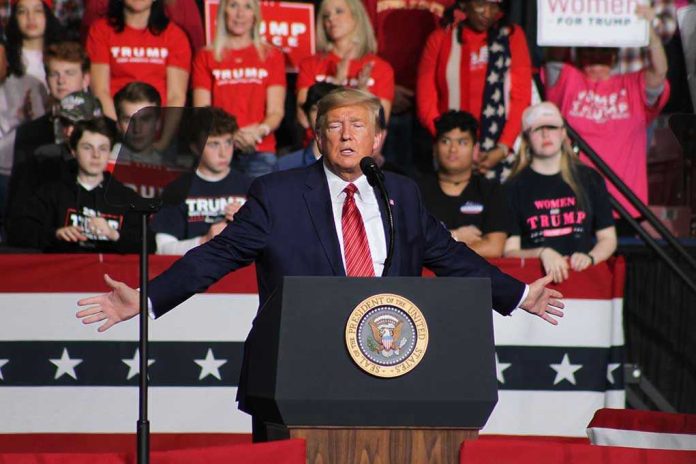
Federal customs duty collections have exploded past $100 billion in a single fiscal year for the first time, as the Trump administration’s tariff blitz sends shockwaves through the economy and delivers a rare budget surplus—leaving Americans to foot the bill for a trade war that’s being spun as a patriotic victory.
At a Glance
- U.S. customs duty collections surged to over $100 billion in fiscal 2025, more than doubling last year’s total.
- Trump’s “Liberation Day tariffs” catapulted the average tariff rate from 2.5% to 27%, the steepest hike in over a century.
- June 2025 saw a rare $27 billion federal budget surplus, fueled by this tariff windfall.
- Consumers and businesses face sharply higher costs as the administration boasts of fiscal “vindication.”
Tariffs Hit Historic Highs—And So Does the Price Tag for Americans
For the first time in American history, U.S. customs duty collections have smashed through the $100 billion threshold in a single fiscal year. The numbers are staggering: as of July 6, 2025, the federal government had raked in $98.6 billion in customs duties—an astonishing 110.5% jump from the previous year’s total. This fiscal windfall is a direct result of the Trump administration’s “Liberation Day tariffs,” which took effect in April and instantly jacked the average U.S. tariff rate from a manageable 2.5% to a punishing 27%—the highest since the days of the Smoot-Hawley disaster nearly a century ago.
The administration’s pitch couldn’t be clearer: tariffs are framed as a patriotic tool to “level the playing field,” address the trade deficit, and punish foreign governments for their supposed economic offenses. Yet, while the Treasury Department is busy counting stacks of cash, shoppers and small businesses are left wondering where this “victory” leaves them. As history has shown, tariffs might fill government coffers in the short term, but the bills always come due—and it’s regular Americans who pay them, not the foreign exporters or Chinese bureaucrats. There’s no such thing as a free lunch, no matter how many times politicians try to serve it up with a red, white, and blue garnish.
Liberation or Pyrrhic Victory? The Real Price of “Economic Sovereignty”
The so-called “Liberation Day tariffs” rolled out in April 2025 are being hailed by the administration as a bold strike for economic sovereignty. President Trump and his advisors have not been shy about celebrating these measures, touting the tariffs as “reciprocal” and long overdue. The White House claims these tariffs finally force other countries to play by American rules. Rhetoric aside, the numbers say it all: collections of customs duties have never been higher, and for the first time in years, the federal government posted a $27 billion budget surplus in June.
But here’s the catch: while Washington basks in this revenue surge, the pain is radiating outward. Importers and retailers are scrambling to adjust, facing higher costs across the board. Many have no choice but to pass those costs straight to the American consumer. It’s a classic case of government picking winners and losers—protecting some domestic industries while leaving others and the families who rely on them to absorb the shock. If this is what victory looks like, it’s fair to ask: who exactly is winning?
Who Pays for the Party? The Real-World Fallout from Tariff Mania
Despite the chest-thumping from the administration, the reality is far less rosy for everyday Americans. Economists from across the spectrum have pointed out—again and again—that tariffs are nothing more than a tax on imports. They raise the cost of everything from clothing and electronics to groceries and machinery. The Penn Wharton Budget Model, hardly a bastion of left-wing activism, notes that while tariff revenues are surging, they’re still a drop in the bucket compared to broad-based income taxes—and they’re hardly a sustainable replacement.
Meanwhile, supply chains are in upheaval as businesses race to source goods from countries that haven’t been hit with new tariffs. This might sound like a clever workaround, but it comes with its own set of costs, complications, and (inevitably) higher prices at the register. Worse yet, lower-income Americans are hit the hardest, since they spend a greater share of their budget on imported goods. So much for protecting the little guy: the administration’s tariffs are a textbook example of big government “help” that ends up helping itself first.
Tariffs: A Tool for Revenue or a Recipe for Disaster?
Supporters of the tariff blitz argue it’s a necessary correction to decades of “unfair” trade, a way to finally stand up to foreign freeloaders and bring jobs back to America. But critics—including a chorus of economists and even some business-friendly Republicans—warn that this kind of heavy-handed intervention is as likely to kneecap the economy as it is to save it. History offers a sobering lesson: the last time tariffs soared to this level, in the 1930s, the result was a deepening of the Great Depression and a global trade slump.
The administration is banking on short-term fiscal gains to sell the American people on a policy that brings long-term pain. The $100 billion milestone is being spun as proof that tariffs work, but don’t be fooled by the headlines—this is revenue wrung from the wallets of hard-working American families and businesses, not the foreign governments these tariffs claim to target. As the dust settles, the question remains: will this be remembered as a moment of economic “liberation,” or a costly blunder dressed up in patriotic rhetoric?



